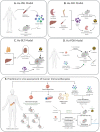Modeling human tumor-immune environments in vivo for the preclinical assessment of immunotherapies
- PMID: 33830275
- PMCID: PMC8423639
- DOI: 10.1007/s00262-021-02897-5
Modeling human tumor-immune environments in vivo for the preclinical assessment of immunotherapies
Abstract
Despite the significant contributions of immunocompetent mouse models to the development and assessment of cancer immunotherapies, they inadequately represent the genetic and biological complexity of corresponding human cancers. Immunocompromised mice reconstituted with a human immune system (HIS) and engrafted with patient-derived tumor xenografts are a promising novel preclinical model for the study of human tumor-immune interactions. Whilst overcoming limitations of immunocompetent models, HIS-tumor models often rely on reconstitution with allogeneic immune cells, making it difficult to distinguish between anti-tumor and alloantigen responses. Models that comprise of autologous human tumor and human immune cells provide a platform that is more representative of the patient immune-tumor interaction. However, limited access to autologous tissues, short experimental windows, and poor retention of tumor microenvironment and tumor infiltrating lymphocyte components are major challenges affecting the establishment and application of autologous models. This review outlines existing preclinical murine models for the study of immuno-oncology, and highlights innovations that can be applied to improve the feasibility and efficacy of autologous models.
Keywords: Animal models; Autologous models; Cancer; Immune-system; Immunotherapies; Preclinical Safety-assessment/risk management.
© 2021. The Author(s).
Conflict of interest statement
We declare there are no conflicts of interest associated with this review.
Figures


Similar articles
-
Establishment of humanized tumor microenvironment mouse models based on the injection of peripheral blood mononuclear cells and IFN-γ to evaluate the efficacy of PD-L1/PD-1-targeted immunotherapy.Cancer Biol Ther. 2020;21(2):130-138. doi: 10.1080/15384047.2019.1670520. Epub 2019 Nov 6. Cancer Biol Ther. 2020. PMID: 31690181 Free PMC article.
-
Humanized Mice for the Study of Immuno-Oncology.Trends Immunol. 2018 Sep;39(9):748-763. doi: 10.1016/j.it.2018.07.001. Epub 2018 Aug 2. Trends Immunol. 2018. PMID: 30077656 Review.
-
Characterization of immune responses to anti-PD-1 mono and combination immunotherapy in hematopoietic humanized mice implanted with tumor xenografts.J Immunother Cancer. 2019 Feb 8;7(1):37. doi: 10.1186/s40425-019-0518-z. J Immunother Cancer. 2019. PMID: 30736857 Free PMC article.
-
The humanized mouse: Emerging translational potential.Mol Carcinog. 2020 Jul;59(7):830-838. doi: 10.1002/mc.23195. Epub 2020 Apr 10. Mol Carcinog. 2020. PMID: 32275343 Review.
-
Fidelity of human ovarian cancer patient-derived xenografts in a partially humanized mouse model for preclinical testing of immunotherapies.J Immunother Cancer. 2020 Nov;8(2):e001237. doi: 10.1136/jitc-2020-001237. J Immunother Cancer. 2020. PMID: 33177175 Free PMC article.
Cited by
-
Immune-related adverse events of antibody-based biological medicines in cancer therapy.J Cell Mol Med. 2024 Jul;28(13):e18470. doi: 10.1111/jcmm.18470. J Cell Mol Med. 2024. PMID: 38963257 Free PMC article. Review.
-
Fc-competent multispecific PDL-1/TIGIT/LAG-3 antibodies potentiate superior anti-tumor T cell response.Sci Rep. 2023 Jun 18;13(1):9865. doi: 10.1038/s41598-023-36942-3. Sci Rep. 2023. PMID: 37332070 Free PMC article.
-
Patient-derived xenograft models in cancer therapy: technologies and applications.Signal Transduct Target Ther. 2023 Apr 12;8(1):160. doi: 10.1038/s41392-023-01419-2. Signal Transduct Target Ther. 2023. PMID: 37045827 Free PMC article. Review.
-
Head and Neck Cancer Immunotherapy: Molecular Biological Aspects of Preclinical and Clinical Research.Cancers (Basel). 2023 Jan 30;15(3):852. doi: 10.3390/cancers15030852. Cancers (Basel). 2023. PMID: 36765809 Free PMC article. Review.
-
Mesothelin CAR T Cells Secreting Anti-FAP/Anti-CD3 Molecules Efficiently Target Pancreatic Adenocarcinoma and its Stroma.Clin Cancer Res. 2024 May 1;30(9):1859-1877. doi: 10.1158/1078-0432.CCR-23-3841. Clin Cancer Res. 2024. PMID: 38393682 Free PMC article.
References
Publication types
MeSH terms
LinkOut - more resources
Full Text Sources
Other Literature Sources

